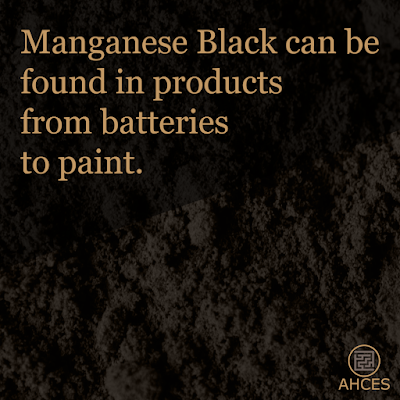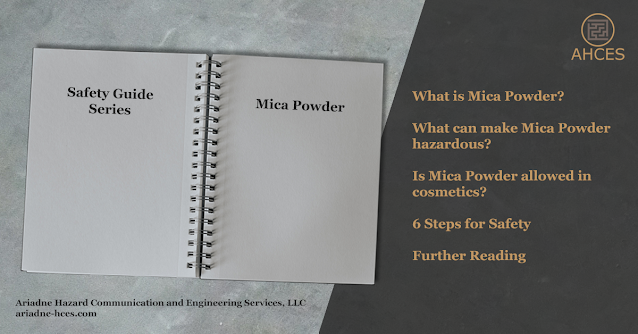Manganese Black Safety Guide
What is Manganese Black?
Manganese Black is a mineral compound also known as manganese dioxide, manganese (IV) oxide, pyrolusite, cement black, pigment black 14, and pigment brown 8. Manganese black has many uses, including as a component in dry-cell batteries, and as a pigment.
Manganese Black has the CAS Number 1313-13-9
The CAS Number is used to identify manganese black as an ingredient on safety data sheets (SDS) and other safety documentation. When looking for manganese black as an ingredient in products like paints, look for the CAS Number in the composition table.
Notable Properties of Manganese Black
Manganese black is dark grey to brownish black in color and tends to be in a powdered form. It is naturally odorless.
Pyrolusite is the mineral name for manganese dioxide and is the most common mined source for manganese used in industrial processes.
What Makes Manganese Black Hazardous?
Manganese black is considered a respiratory irritant. Breathing in manganese black powder can lead to bronchitis, pneumonia, and other respiratory ailments.
Chronic exposure to manganese black, and other manganese compounds, can lead to an illness known as manganism, which has neurological symptoms similar to Parkinson's Disease. Accordingly, OSHA has assigned a permissible exposure limit (PEL) value of 5 mg/m3. This is particularly important for an industrial facility working with large quantities of manganese black, such as dry-cell battery producers, manganese steel producers, or large-scale pigment manufacturers.
Manganese black is also an oxidizer. As an inorganic compound it is not directly flammable, but as an oxidizer it can make fires worse. Keep away from flammable substances including paper and wood.
Manganese Black Frequently Asked Questions
Is manganese black toxic?
Manganese black is chronic or repeated-exposure toxin. Long term exposure to manganese black, or other manganese compounds can lead to manganism.
Is manganese dioxide soluble in water? Does manganese dioxide react with water?
Manganese black is not soluble in water, nor does it react with water.
6 Steps for Safety
Step 1: Read the Warnings
When working with a product for the first time, always read all the safety documents first. This includes safety data sheets, which should be provided by the manufacturer or importer of the manganese black product. There may also be an OSHA chemical label, a Consumer Protection label, or AMCI label on the packaging of the manganese black product. These documents all contain important information on the hazards of the product and instructions on how to mitigate those hazards.
Different compositions in different products may cause additional hazards to be present beyond the properties of product with manganese black as the only active ingredient. Be sure to familiarize yourself with the differences between separate manganese black based products.
For example, the oils used in oil paints, including linseed oil and poppy oil, are combustible. Especially considering that manganese black is an oxidizer, extra fire precautions should be taken when working with products that have this combination of ingredients.
Step 2: Prepare Your Workspace
Creating a safe workspace, sometimes referred to as engineering control, is a key component of working safely with any potentially hazardous substance.
For example, if the manganese black product is in a powder form, then any dust will have to be kept under control. A fan which would blow dust particles around should be avoided. A dust collection with a filter to capture dust is recommended.
Step 3: Gather Your PPE
For working with manganese black powder, you will need
the following PPE.
- Respiratory Protection
- A dust mask meant for inorganic particles will protect the respiratory system from irritation from accidentally breathing in dust particles.
Step 4: Clear Your Workspace
Having a clear workspace is an important part of safety. Clutter can cause accidents and can prevent you from noticing if something has spilled.
This is also a good time to double check any engineering controls are in proper working order, such as replacing the filters on a dust collector.
If you are working in a shared space, make sure anyone around you can also remain safe when you are working with manganese black products. For those working at home, this can include family members and pets.
Step 5: Do The Work
If engineering controls and PPE are used properly, and the material is kept away from fire, working with manganese black has minimal hazards.
If work cannot be completed in one sitting, be sure to properly seal any manganese black containers to prevent spills or accidental release when not in use.
Step 6: Clean Up
Dust generation should be avoided when cleaning up solid manganese black. Either a vacuum with a filter or a damp cleaning cloth can be used to pick up spilled any stray solid manganese black while preventing dust generation.
Be sure to dispose of any waste in accordance with local regulations. This is particularly important with liquid paint products. Many areas require any liquid paints be allowed to complexly harden before disposal.
Further Reading
The National Library of Medicine has a PubChem Manganese Black Summary. Haz-Map also has an article under the name Manganese Dioxide, which is synonymous with manganese black.
For more information about magnesium toxicity, Science Direct has an article on Manganism.
Check out the Safety
Guide Series Hub for more safety guides.
Sources Cited
Haz-Map (n.d.). Manganese dioxide. Haz-Map.com. Retrieved December 6, 2023, from https://haz-map.com/Agents/2018
National Center for Biotechnology Information (2024). PubChem Compound Summary for CID 14801, Manganese dioxide. Retrieved December 6, 2023 from https://pubchem.ncbi.nlm.nih.gov/compound/Manganese-dioxide.
Original Posting Date: Dec. 6, 2023
Last Updated: Feb. 12, 2024






Comments
Post a Comment